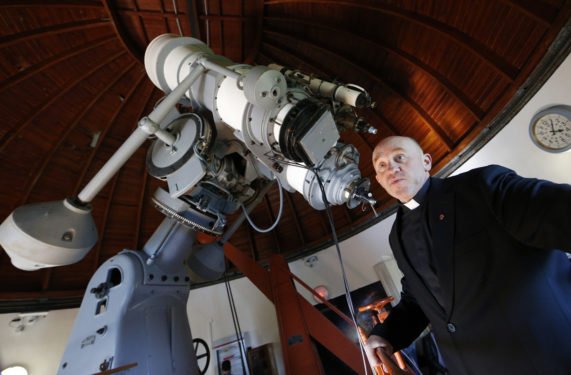By Carol Glatz

VATICAN CITY (CNS) – When people ask why the Vatican has an observatory, one Jesuit priest says it’s because it cannot afford a particle accelerator.
The nerdy quip by the Vatican Observatory’s vice director, Jesuit Father Paul Mueller, has become his signature response to people’s inevitable surprise when they discover that popes have stockpiled telescopes, and the Church does not oppose science – even if it won’t buy a 16-mile long, multibillion-dollar particle accelerator.
Eleven Jesuit astronomers live, work and pray together year-round as they conduct their top-notch research either at the modern Mount Graham International Observatory in Arizona or at their historic headquarters on the grounds of the papal summer villa and gardens in Castel Gandolfo near Rome.
“Science is part of our life; for us there is no conflict, no tension” with their Catholic faith and religious vocation, said Father Mueller, a U.S. priest who has degrees in physics, history, philosophy and theology and a doctorate in the history and philosophy of science.
He spoke to Catholic News Service Sept. 30 during a Vatican-led tour of the observatory’s facilities at the papal villa.
Reporters were treated to a full tour of the four observatory domes and telescopes housed in two separate buildings – one being the papal summer residence with a stunning view of Lake Albano below and the other being a newly refurbished building nestled within the wooded gardens.
The recently renovated facility houses the now fully restored Carte du Ciel (Celestial Map) telescope from 1891, a Schmidt telescope from 1957 and a new exhibit showcasing a number of historical scientific instruments, artifacts and meteorites from the observatory’s collections.
The plan is to open the space to the public starting in the summer 2019 with visits organized by the Vatican Museums. Father Mueller said one idea would be to have groups tour the villa’s garden, have dinner and then open one of the observatory domes for a night of stargazing. The Vatican Museums already organize special tours of the papal villa and gardens at Castel Gandolfo.
While the details have to be worked out, Father Mueller said it will offer a great way to make the historical treasures, work and achievements of the Vatican Observatory more “public and visible.”
